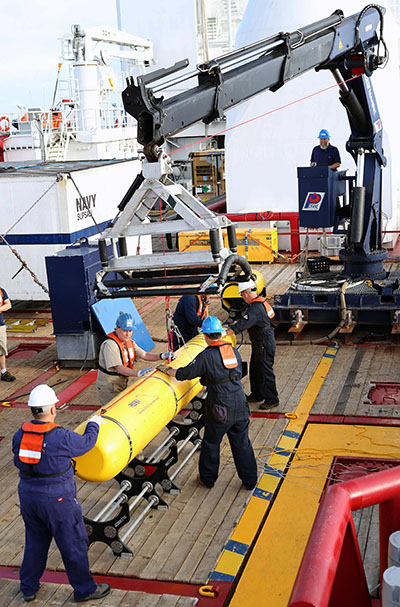 |
|
Crew aboard the Australian Defence Vessel Ocean Shield prepare to deploy the U.S. Navy's Bluefin-21 autonomous underwater vehicle (AUV) in the southern Indian Ocean to look for the missing Malaysia Airlines flight MH370 in this handout picture released by the Australian Defence Force April 15, 2014. [Photo/Agencies] |
CANBERRA, Australia?- Unidentified material that washed ashore in southwestern Australia and is being examined for any link to the lost Malaysian plane is unlikely to have come from the jet, an official said Wednesday.?
The Australian Transport Safety Bureau was scrutinizing photos of the object, which washed ashore 10 kilometers (6 miles) east of Augusta in Western Australia state. But Martin Dolan, chief commissioner of the safety bureau, said an initial analysis of the material?- which appeared to be sheet metal with rivets?- suggested it was not from Malaysia Airlines Flight 370.
Local media the West Australian said that"an ATSB spokesman confirmed that the piece of debris was interesting" and "was eight feet tall, half a metre wide and was an alloy type of metal."
"We do not consider this likely to be of use to our search for MH370," Dolan told The Associated Press. "At this stage, we are not getting excited."
Dolan said the analysis of the material would likely be completed overnight and a formal statement issued Thursday. Augusta is near Australia's southwestern tip, about 310 kilometers (190 miles) from Perth, where the search has been headquartered.
Meanwhile, Australia's prime minister said Wednesday that failure to find any clue in the most likely crash site of the lost jet would not spell the end of the search, as officials plan soon to bring in more powerful sonar equipment that can delve deeper beneath the Indian Ocean.
The search coordination center said a robotic submarine, the U.S. Navy's Bluefin 21, had scanned more than 80 percent of the 310-square kilometer (120-square mile) seabed search zone off the Australian west coast, creating a three-dimensional sonar map of the ocean floor. Nothing of interest had been found.
The 4.5-kilometer (2.8-mile) deep search area is a circle 20 kilometers (12 miles) wide around an area where sonar equipment picked up a signal on April 8 consistent with a plane's black boxes. But the batteries powering those signals are now believed dead.
Defense Minister David Johnston said Australia was consulting with Malaysia, China and the United States on the next phase of the search for the plane, which disappeared March 8. Details on the next phase are likely to be announced next week.
Johnston said more powerful towed side-scan commercial sonar equipment would probably be deployed, similar to the remote-controlled subs that found RMS Titanic 3,800 meters (12,500 feet) under the Atlantic Ocean in 1985 and the Australian WWII wreck HMAS Sydney in the Indian Ocean off the Australian coast, north of the current search area, in 2008.
"The next phase, I think, is that we step up with potentially a more powerful, more capable side-scan sonar to do deeper water," Johnston told the AP.
While the Bluefin had less than one-fifth of the seabed search area to complete, Johnston estimated that task would take another two weeks.
Australian Prime Minister Tony Abbott said the airliner's probable impact zone was 700 kilometers (430 miles) long and 80 kilometers (50 miles) wide. A new search strategy would be adopted if nothing is found in the current seabed search zone.
"If at the end of that period we find nothing, we are not going to abandon the search, we may well rethink the search, but we will not rest until we have done everything we can to solve this mystery," Abbott told reporters.
"We owe it to the families of the 239 people on board, we owe it to the hundreds of millions?- indeed billions?- of people who travel by air to try to get to the bottom of this. The only way we can get to the bottom of this is to keep searching the probable impact zone until we find something or until we have searched it as thoroughly as human ingenuity allows at this time," he said.
The focus of the next search phase will be decided by continuing analysis of information including flight data and sound detections of the suspected beacons, Johnston said.
"A lot of this seabed has not even been hydrographically surveyed before?- some of it has?- but we're flying blind," he said, adding that the seabed in the vicinity of the search was up to 7 kilometers (4 miles) deep.
The search center said an air search involving 10 planes was suspended for a second day because of heavy seas and poor visibility.
But 12 ships would join Wednesday's search of an expanse covering 38,000 square kilometers (14,500 square miles), centered 1,600 kilometers (1,000 miles) northwest of Perth.
Radar and satellite data show the jet veered far off course on March 8 for unknown reasons during its flight from Kuala Lumpur, Malaysia, to Beijing.
An analysis indicates it would have run out of fuel in the remote section of ocean where the search has been focused. Not one piece of confirmed debris has been found since the massive multinational hunt began.
